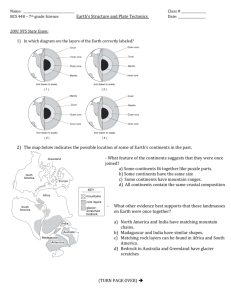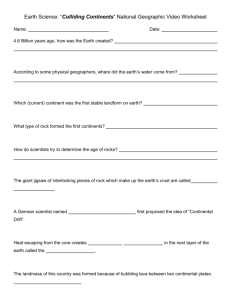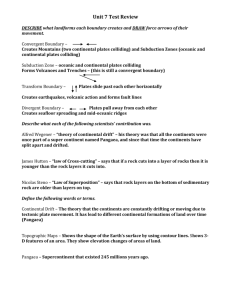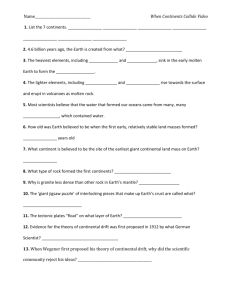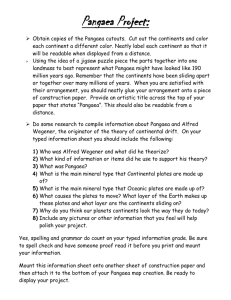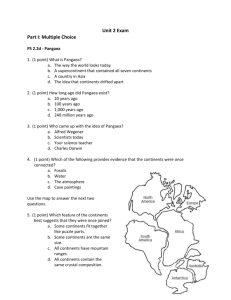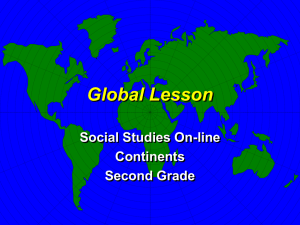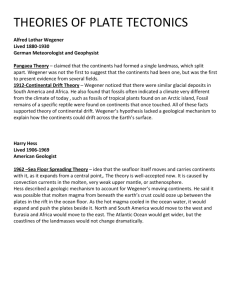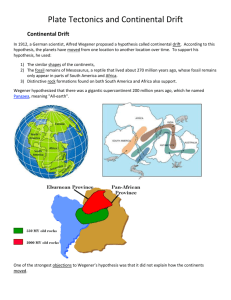Lesson Plan - Western Connecticut State University
advertisement
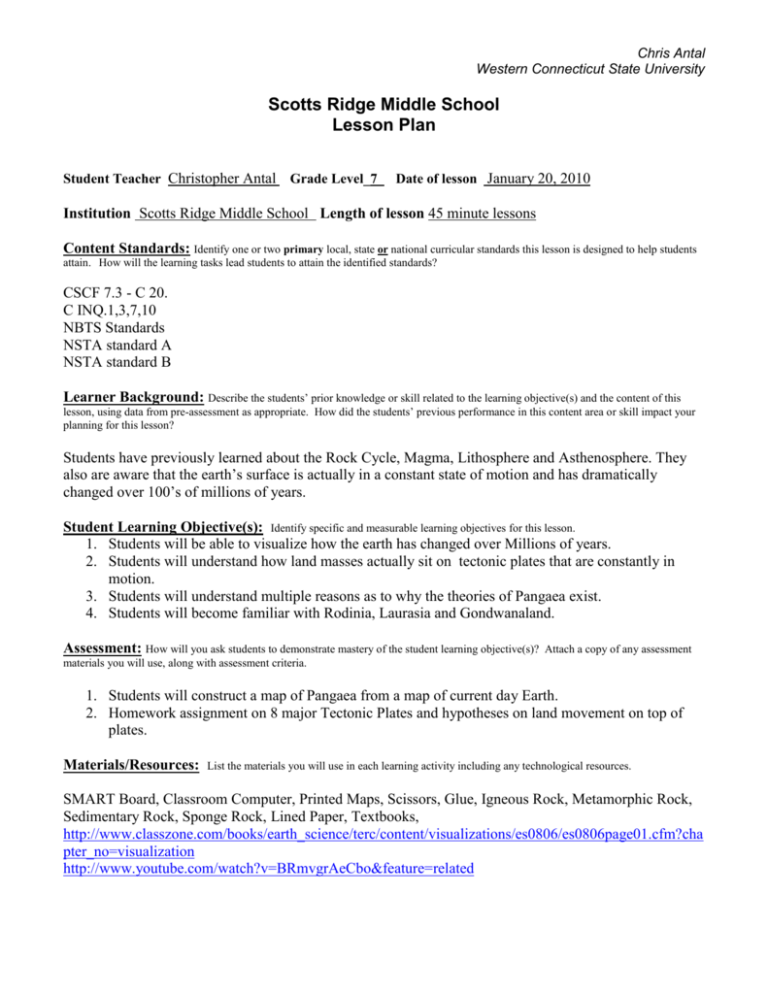
Chris Antal Western Connecticut State University Scotts Ridge Middle School Lesson Plan Student Teacher Christopher Antal Grade Level_7 Date of lesson January 20, 2010 Institution Scotts Ridge Middle School Length of lesson 45 minute lessons Content Standards: Identify one or two primary local, state or national curricular standards this lesson is designed to help students attain. How will the learning tasks lead students to attain the identified standards? CSCF 7.3 - C 20. C INQ.1,3,7,10 NBTS Standards NSTA standard A NSTA standard B Learner Background: Describe the students’ prior knowledge or skill related to the learning objective(s) and the content of this lesson, using data from pre-assessment as appropriate. How did the students’ previous performance in this content area or skill impact your planning for this lesson? Students have previously learned about the Rock Cycle, Magma, Lithosphere and Asthenosphere. They also are aware that the earth’s surface is actually in a constant state of motion and has dramatically changed over 100’s of millions of years. Student Learning Objective(s): Identify specific and measurable learning objectives for this lesson. 1. Students will be able to visualize how the earth has changed over Millions of years. 2. Students will understand how land masses actually sit on tectonic plates that are constantly in motion. 3. Students will understand multiple reasons as to why the theories of Pangaea exist. 4. Students will become familiar with Rodinia, Laurasia and Gondwanaland. Assessment: How will you ask students to demonstrate mastery of the student learning objective(s)? Attach a copy of any assessment materials you will use, along with assessment criteria. 1. Students will construct a map of Pangaea from a map of current day Earth. 2. Homework assignment on 8 major Tectonic Plates and hypotheses on land movement on top of plates. Materials/Resources: List the materials you will use in each learning activity including any technological resources. SMART Board, Classroom Computer, Printed Maps, Scissors, Glue, Igneous Rock, Metamorphic Rock, Sedimentary Rock, Sponge Rock, Lined Paper, Textbooks, http://www.classzone.com/books/earth_science/terc/content/visualizations/es0806/es0806page01.cfm?cha pter_no=visualization http://www.youtube.com/watch?v=BRmvgrAeCbo&feature=related Chris Antal Western Connecticut State University Learning Activities: Identify the instructional grouping (whole class, small groups, pairs, individuals) you will use in each lesson segment and approximate time frames for each. Initiation: Briefly describe how you will initiate the lesson. (Set expectations for learning; articulate to learners what they will be doing and learning in this lesson, how they will demonstrate learning, and why this is important) As the students come into class, they will drop off their homework assignments up front. I will then ask them what they learned about Pangaea from their homework assignments. I will ask them, besides the obvious fit of the continents, what other factors could link the continents together. At which point I will show them a rock that is not only common to the Northeast, but also to North Western Africa. I will then show them a fossil. While it won’t be a specific fossil to the supporting evidence, it will get their attention. Lesson Development: Describe how you will develop the lesson, what you will do to model or guide practice, and the learning activities students will be engaged in order to gain the key knowledge and skills identified in the student learning objective(s). A. I will get the class’s attention by showing them a rock specific to not only the North East, but also specific to North Western Africa. I will then show them a fossil and give them examples of fossils of closely related species that have been discovered in different areas of the world. I will explain to them that not only do the shapes of the continents support the theory of Pangaea, but items such as rocks and fossils support the theory as well. B. From there I will give them a handout of a map with the continents on them, including the various rock types and fossils. They will then cut out the continents and construct their own hypothetical versions of Pangaea, using the assistance of pairing rock types and fossils indicated on the map. C. The students will have 15 minutes to construct their maps. If they have not finished, they will have to finish the assignment for homework. If students finish ahead of time, they will be given the option to help others in the class, or to research plate tectonics on their computers. D. The class will then watch a brief YouTube skit on the evolution of the earth from Pangaea to Laurasia/Gondwanaland, to our 7 current continents. I will then break down the process in detail. I will also explain to the class that there are theories that before Pangaea existed, in particular, the super continent that existed 1100-700 million years ago, known as Rodinia. I will then provide a link on the class webpage to an interactive map of the continents over the last 150 million years. I will encourage them to take a look at this and see if they can get an idea of how each plate is moving. E. From there I will explain to the class that the continents themselves actually lie on top of Tectonic Plates. However the plates do not just end where the land mass end. Many extend out into the middle of the oceans and some don’t even contain continents. Closure: Briefly describe how you will close the lesson and help students understand the purpose of the lesson. (Interact with learners to elicit evidence of student understanding of purpose(s) for learning and mastery of objectives) After explaining the concept of Tectonic Plates, I will ask the class “How is it that these continents used to fit together even though they sit on top of these 8 large plates? Do the continents move on Chris Antal Western Connecticut State University top or the plates?” I will leave them with that for a homework assignment to research. They will also need to complete a map of the tectonic plates, citing one fact they learned about each plate. Individuals Needing Differentiated Instruction: Describe 1 to 3 students with learning differences. These students may be special or general education students and need not be the same students for each lesson. Students may represent a range of ability and/or achievement levels, including students with IEPs, gifted and talented students, struggling learners, and English language learners. Note: Differentiated instruction may not be necessary in every lesson. However, over the course of the student teaching placement, it is expected that each student teacher will demonstrate the ability to differentiate instruction in order to meet the needs of students with learning differences. Which students do you anticipate may struggle with the content/learning objectives of this lesson? Student name Evidence that the student needs How will you differentiate instruction in this lesson to support student differentiated instruction learning? Oscar Robertson Currently reading at 4th grade The lesson is designed to be demonstrational as well as highly interactive. level. Acts out frequently. The student will be able to keep up during the lessons. Oscar will also assist me with distributing safety glasses as a means of establishing a bond between Oscar and I. Oscar also is aware of my extra time after school for help with homework. Which students will need opportunities for enrichment/higher level of challenge? Student name Evidence that the student needs How will you differentiate instruction in this lesson to support student differentiated instruction learning? Dwight Howard Dwight has not received a grade I will ask Dwight the difficult questions, the rest of the class may be lower than a 97% all year. He struggling with. He will also be asked to complete a research paper each always has the answers in class semester on the subjects he found most interesting. These papers could be discussions. substituted for other projects he may find unchallenging. Notes from the pre-conference
